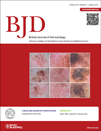Delusional infestation and the specimen sign: a European multicentre study in 148 consecutive cases
Funding sources None.
Conflicts of interest P.L. has accepted honoraria from AstraZeneca and Ely Lilly for educational talks during the last 5 years. The remaining authors have no conflicts of interest to declare.
Summary
Background Systematic studies of delusional infestation (DI), also known as delusional parasitosis, are scarce. They lack either dermatological or psychiatric detail. Little is known about the specimens that patients provide to prove their infestation. There is no study on the current presentation of DI in Europe.
Objectives To determine the number of true infestations, to assess with which pathogens patients believe themselves to be infested, and to gather details about the frequency and nature of the specimens and the containers used to store them, based on European study centres.
Methods Retrospective study of consecutive cases with suspected DI from six centres (Dermatology, Psychiatry, Tropical Medicine) in four European countries (U.K., Germany, Italy, France).
Results In total, 148 consecutive cases of suspected DI were included, i.e. the largest cohort reported. None of the patients had evidence of a genuine infestation, as shown by examinations by dermatologists and/or infectious disease specialists. Only 35% believed themselves to be infested by parasites; the majority reported a large number of other living or inanimate (17%) pathogens. Seventy-one patients (48%) presented with what they believed was proof of their infestation. These specimens were mostly skin particles or hair, and rarely insects (only very few of which were human pathogenic or anthropophilic, and none of these could be correlated with the clinical presentation), and only 4% were stored in matchboxes (three of 71).
Conclusions This first multicentre study of DI in Europe confirms that the term ‘delusional infestation’ better reflects current and future variations of this entity than ‘delusional parasitosis’. The presentation of proofs of infestation, commonly referred to as ‘the matchbox sign’, is typical but not obligatory in DI and might better be called ‘the specimen sign’.




